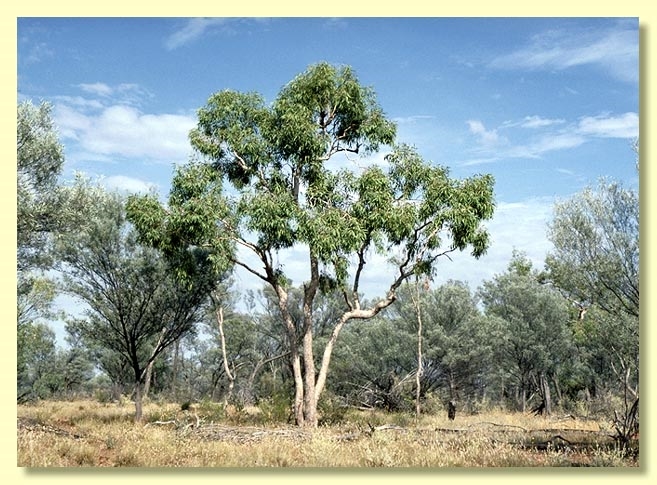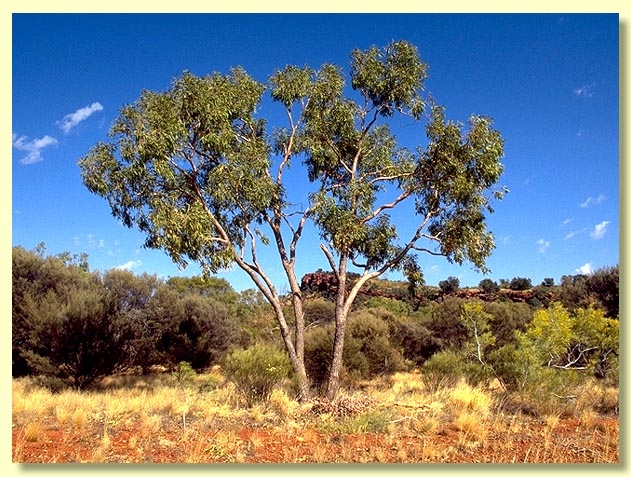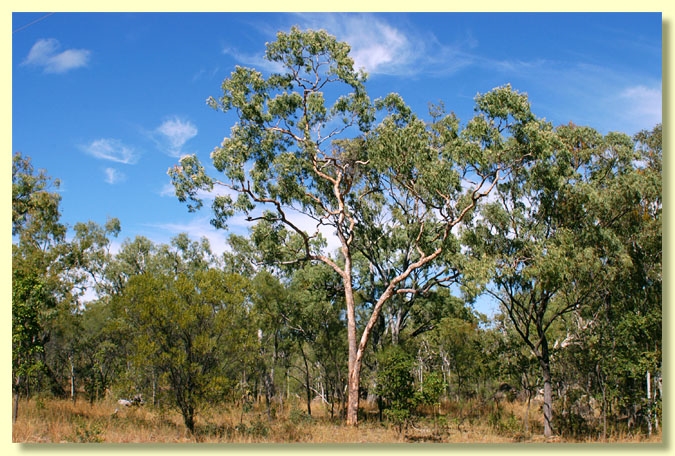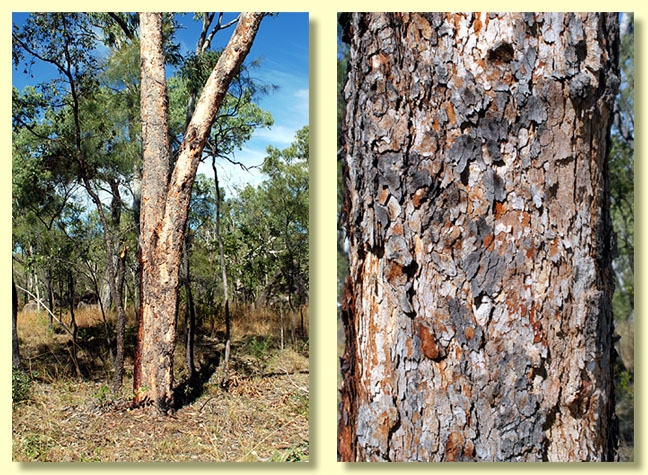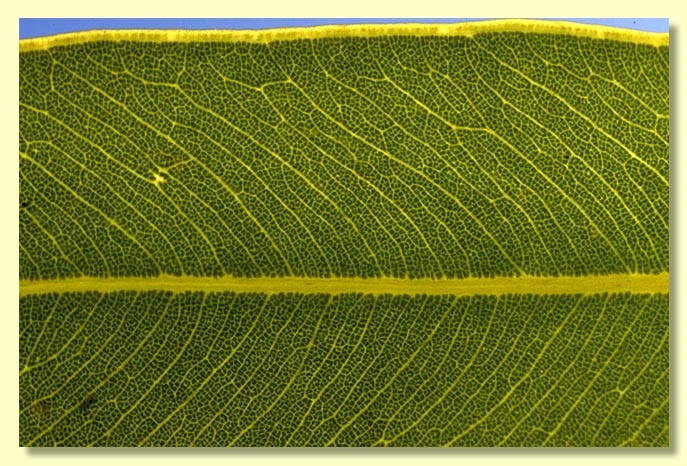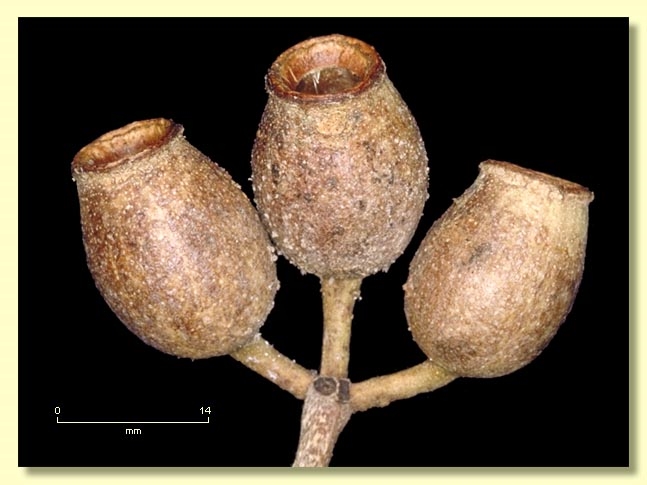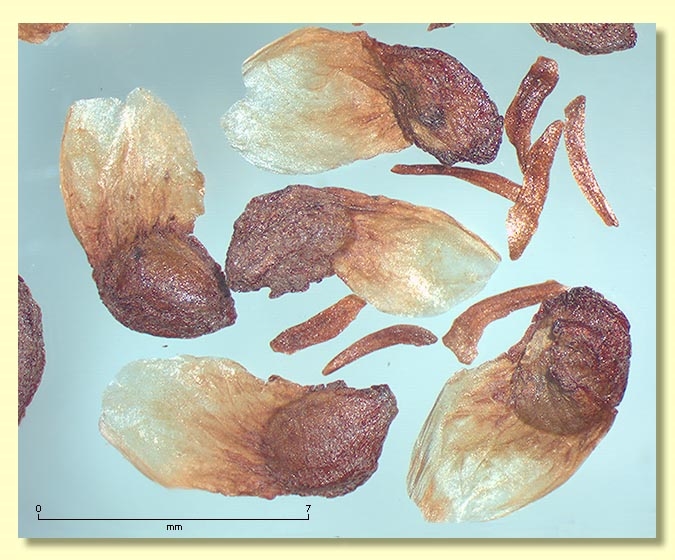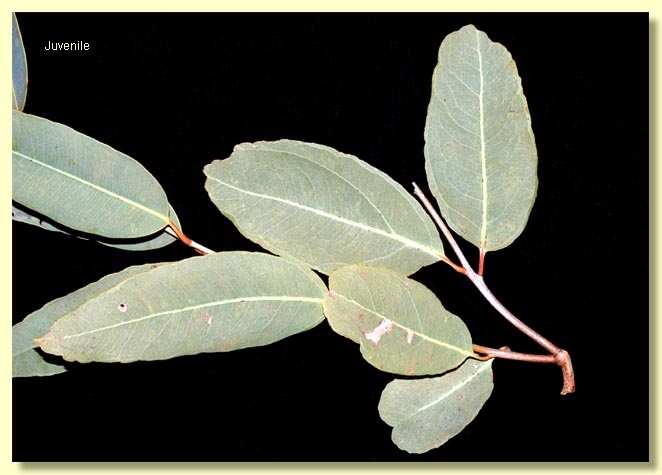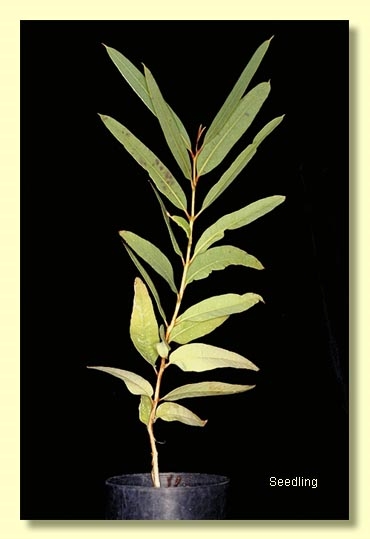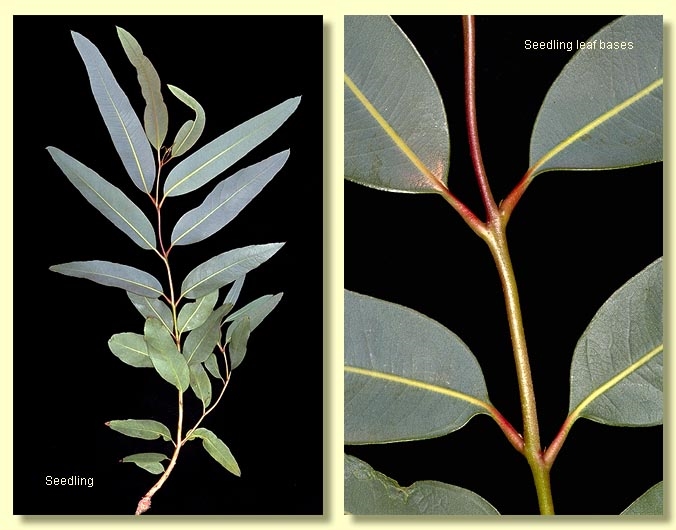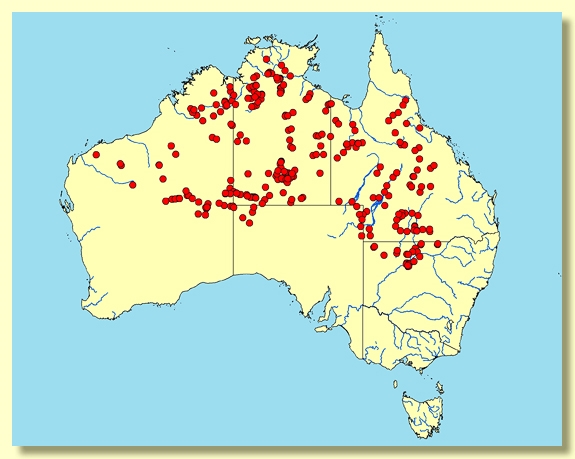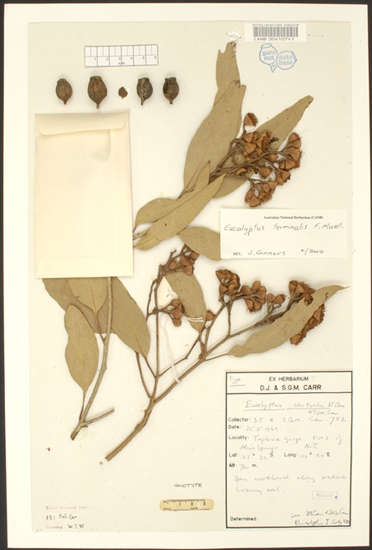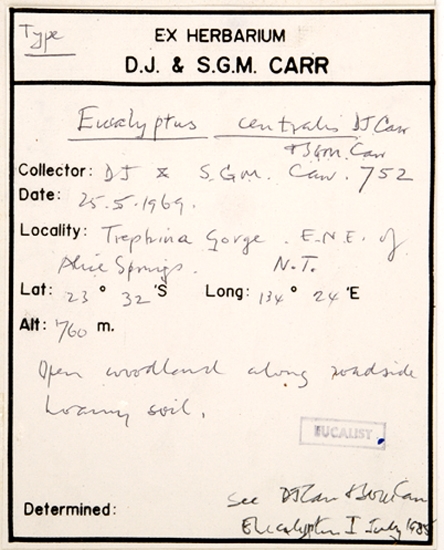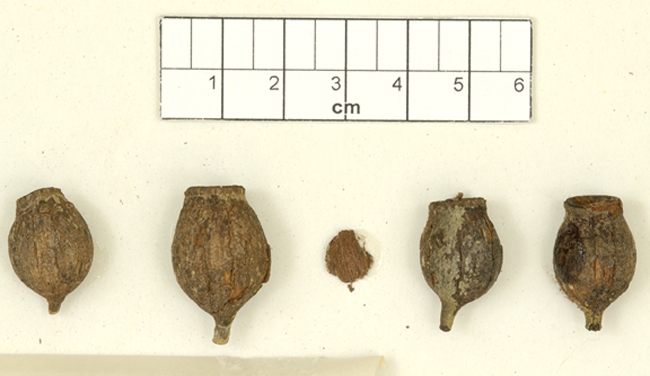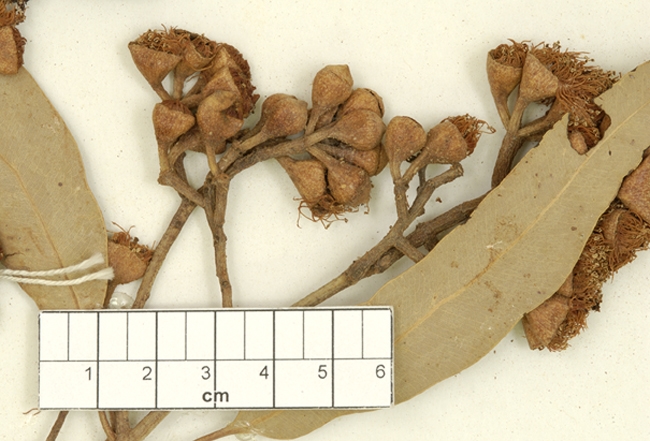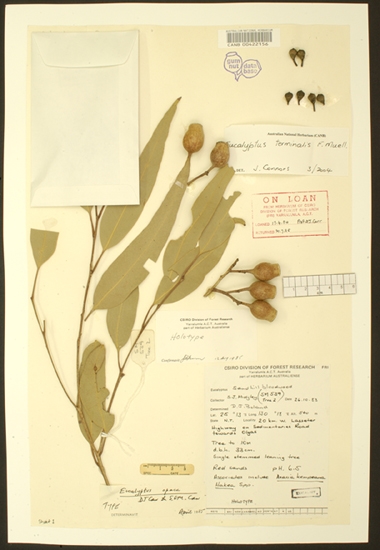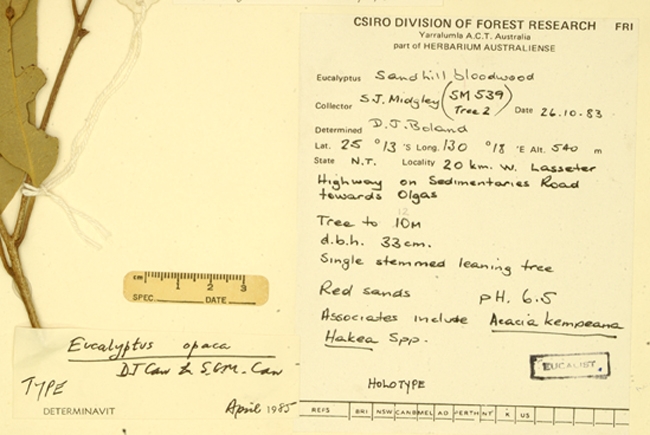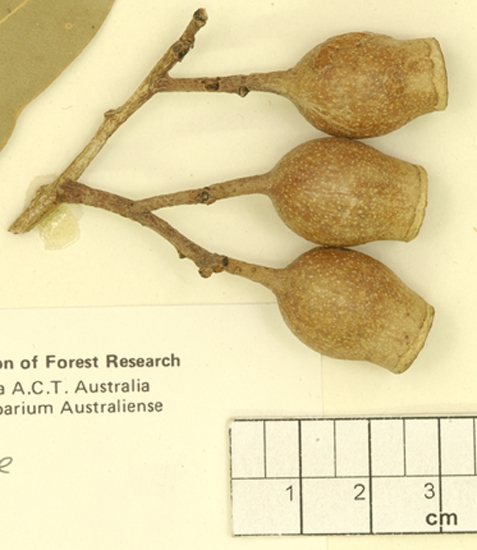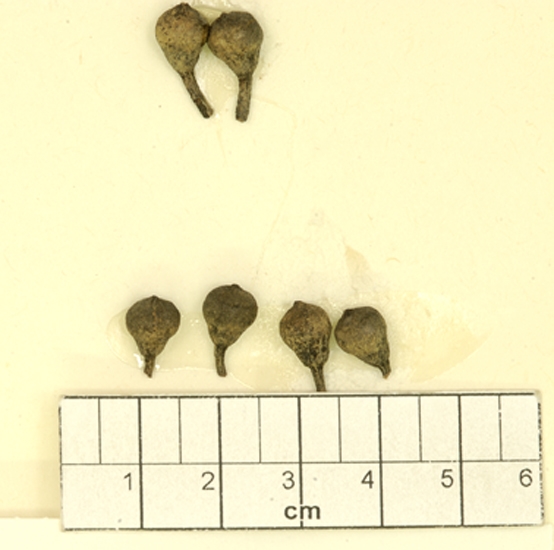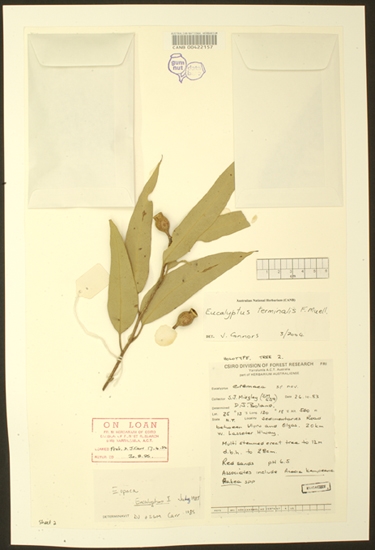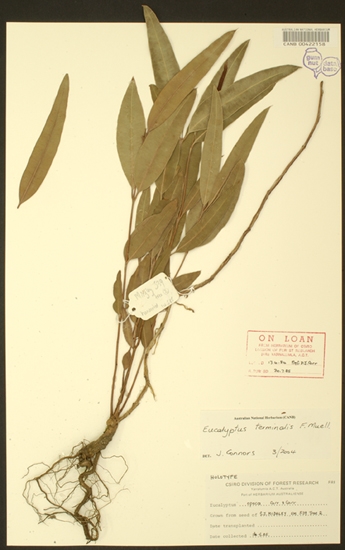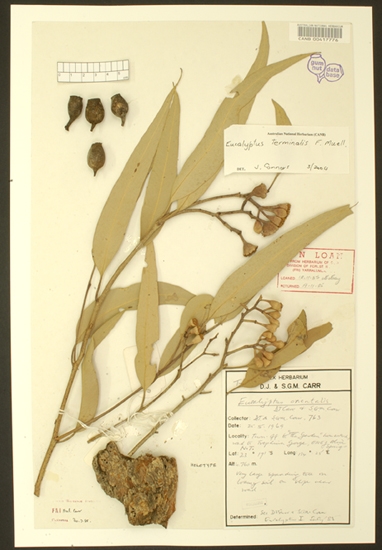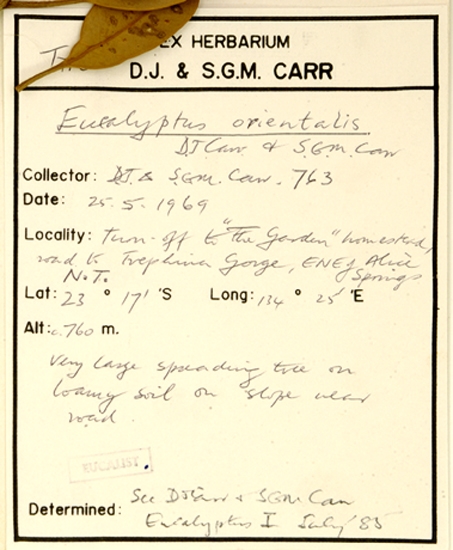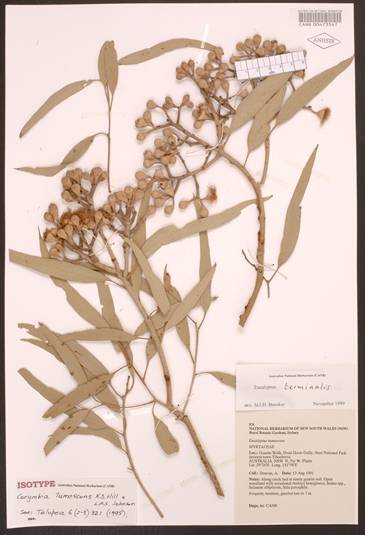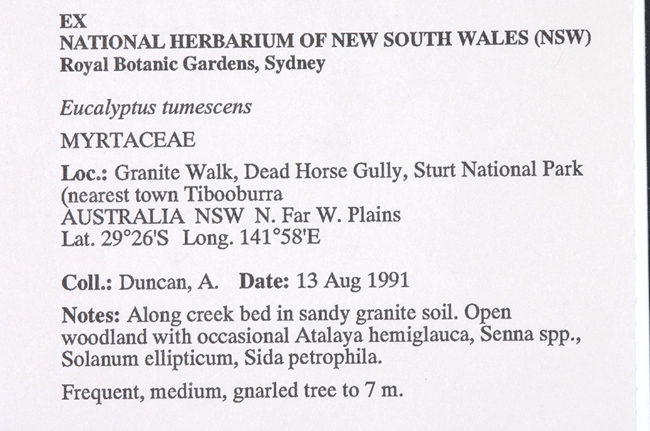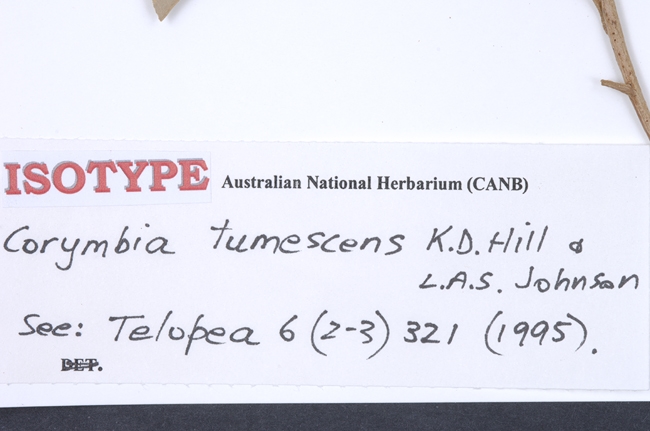Euclid - Online edition
Corymbia terminalis
Corymbia | Rufaria
Corymbia terminalis (F.Muell.) K.D.Hill & L.A.S.Johnson, Telopea 6: 323 (1995).
Eucalyptus terminalis F.Muell., J. Proc. Linn. Soc., Bot. 3: 89 (1859). T: Arnhem land, N.T., July 1856, F.Mueller s.n.; holo: MEL; iso: K.
Eucalyptus pyrophora Benth., Fl. Austral., 3: 257 (1867). T: Northern Territory: Upper Victoria River, F.Mueller 856; lecto: K; isolecto: MEL. (see: K.D.Hill & L.A.S.Johnson, Telopea 6: 323 (1995) for further notes on typification).
Bark rough on part or all of trunk, sometimes extending to the larger branches but not uncommonly on lower trunk only, tessellated, light brown to light grey or, where flakes have recently shed, reddish, pink or orange; bark of larger limbs may be rough or smooth; smooth bark whitish or cream.
Juvenile growth (coppice or field seedlings to 50 cm): stems rounded in cross-section, setose in early stages; juvenile leaves opposite and petiolate for many pairs, ovate to elliptical to lanceolate, 6–17 cm long, 1.2–4.5(5.2) cm wide, base tapering to petiole, apex rounded on lowest leaves, becoming acute higher up stem, margin subcrenulate on lowest leaves then entire, slightly discolorous, green to grey-green, usually glabrous, even lower leaves.
Adult leaves alternate, petiole 1–3 cm long; blade lanceolate, 8–20 cm long, 1.2–3 cm wide, base usually tapering to petiole, concolorous, slightly glossy or dull, pale green to yellowish green, strongly penniveined, very densely reticulate, intramarginal vein absent, oil glands few and island, or absent.
Inflorescence terminal compound, peduncles 0.5–2 cm long, buds 7 per umbel, pedicels 0.2–1.3 cm long. Mature buds ovoid to pyriform, 0.6–1.4(1.7) cm long, 0.5–1(1.3) cm wide, greenish to brown or cream, scurfy, scar absent (both opercula shed together at flowering), operculum shallowly conical to rounded or flattened, stamens inflexed, anthers oblong, versatile, dorsifixed, dehiscing by longitudinal slits (non-confluent), style long, stigma slightly mop-like, locules usually 4, the ovules not arranged in distinct vertical rows on the placentae. Flowers white, very rarely pink.
Fruit pedicellate (pedicels 0.2–1.2 cm wide), urceolate, (1.3)1.5–3.1 cm long, 1.2–2.2 cm wide, disc vertically descending, valves, usually 4, enclosed.
Seeds light brown or reddish brown, ellipsoidal with terminal membraneous wing, 9–12 mm long (including wing), surface smooth, hilum subterminal.
Cultivated seedlings (measured at node 10): cotyledons reniform; stems round in cross-section, slightly scabrid on the lower stem then smooth, leaves petiolate (shortly petiolate on lower leaves), opposite to sub-opposite becoming alternate at ca node 12, lanceolate to narrowly lanceolate, occasionally oblong to elliptical, 4–15.5 cm long, 1–2.8(3.5) cm wide, base rounded or tapering, dull grey to grey-green, apex acute to apiculate to occasionally rounded, setae sparse on lowest two leaf pairs then glabrous.
Flowering has been recorded in March, April, May, June, July, August, September and October.
A small to medium-sized tree widespread in arid central and seasonally dry northern Australia (New South Wales, South Australia, Western Australia, Queensland and Northern Territory). It is absent from wetter monsoonal areas. Corymbia terminalis has rough tessellated bark over part or all of the trunk and sometimes large limbs, often colourful with newly exposed orange underbark. The adult leaves are alternate, usually concolorous, dull or maturing slightly glossy, pale green to yellow-green, with oil glands in the leaves sparse or not visible, and the intramarginal vein is not visible. Buds are conspicuously scurfy and fruit urceolate.
The authors of EUCLID include C. opaca and C. tumescens in a broad concept of C. terminalis. The names C. opaca and C. tumescens are used in some Australian State herbaria but not by other herbaria, when referring to these central Australian bloodwoods.The other names shown as synonyms above are more widely acknowledged to be synonyms.
In southern Australia, C. terminalis is restricted to far north-western New South Wales, e.g. Louth, Wanaaring, Enngonia, and the extreme north of South Australia (e.g. Innamincka, Cordillo Downs) extending into Western Australia to just east and north of the Pilbara Region. The species extends north to the southern and eastern fringes of the Kimberley region and across the Northern Territory from Kulgera in the south as far north as Katherine, and into Queensland east to about Georgetown, Greenvale, Clermont, Barcaldine and Cunnumulla.
C. terminalis differs from other alternate-leaved bloodwood species in the southern area by the scurfy buds (smooth in C. eremaea and C. chippendalei) and fruit with a prominent neck (neck usually lacking in C. chippendalei). The hill-dwelling species from central Australia, C. eremaea, further differs from C. terminalis in having smaller fruit. C. eremaea can be reduced to a smooth-barked spindly mallee on harsh sites. In the desert country just north of Wiluna in Western Australia C. lenziana occurs. It differs from C. terminalis in having obvious pendulous branches, smaller, narrower adult leaves, smooth buds and fruit lacking a neck. In the far west of the range of C. terminalis another bloodwood occurs, C. hamersleyana. It differs in having more globoid and slightly less scurfy buds, and slightly smaller fruit though the dimensions overlap. C. hamersleyana is found on hills with little soil and on lower country with shallow red sandy soil over bedrock, whereas in this region C. terminalis is found on the desert plain sandy loams to the north and east of the Pilbara. C. hamersleyana and C. terminalis are very close morphologically.
Of the alternate-leaved bloodwoods occurring in the north-western part of the species range, C. terminalis is most likely to be confused with C. greeniana (here including C. dampieri, C. byrnesii and C. curtipes) but differs in having more extensive and thicker rough bark, scurfy buds (smooth in C. greeniana) and generally narrower and smaller ovate-elliptic-lanceolate juvenile leaves (usually broadly ovate in C. greeniana, although the dimensions do overlap slightly). C. cliftoniana differs from C. terminalis in having more extensive thick rough bark, smooth buds and squat ± isodiametric (globode) fruit.
Of the alternate-leaved bloodwoods across the northern part of the species range of C. terminalis other rough-barked bloodwoods are: C. umbonata, which has much thinner rough bark, smooth buds and often smaller fruit (though the dimensions do overlap); C. latifolia, which has much broader adult and juvenile leaves, slightly smaller fruit and thinner rough bark; C. ptychocarpa differs in its adult leaves which are discolorous (paler on the underside), and larger scurfy buds, often pink to red flowers and larger barrel-shaped fruit without a neck; and C. polycarpa, which has discolorous leaves, slender scurfy buds and narrow barrel-shaped fruit without a neck.
In the east of the range of C. terminalis, rough-barked and alternate-leaved bloodwoods which may be confused are: C. erythrophloia, which has smooth buds and reddish brown rough bark; C. pocillum, which has smaller smooth buds and smaller fruit; and C. brachycarpa, C. clarksoniana, C. clandestina, C. hendersonii, C. lamprophylla, C. ligans, C. plena and C. serendipita, all of which have discolorous adult leaves.
In the classification of Brooker (2000), Eucalyptus terminalis is included in Eucalyptus subgenus Corymbia (the red bloodwoods) and in their field guide, Brooker & Kleinig (1994) applied this name in much the same way as we do in EUCLID. Hill and Johnson (1995) named this species Corymbia terminalis and applied this name only to plants growing in the area from the Victoria River district of the Northern Territory east through the Gulf of Carpentaria hinterland and Barkly Tableland to Einasleigh and Clermont in Queensland. More westerly and southerly populations they ascribed to Corymbia opaca and C. tumescens. In EUCLID we consider these three taxa to be the same species, viz. Corymbia terminalis for the following reasons.
Measurements of mature buds and fruits of C. terminalis as defined in EUCLID show that the largest buds and fruit occur in the Victoria River District in the Northern Territory east to Wollogorang and extending south of the Gulf of Carpentaria to the western Newcastle Range in Queensland. Plants in the Barkly Tableland area also have fairly large buds, whilst further south buds are generally smaller. Small buds seem to be absent from the Gulf of Carpentaria hinterland, virtually absent from the Victoria River District but commonly present in Central Australia and on the plain country to the east and north of the Pilbara. However, within these southern areas large buds and fruit also occur. There is a greater range of mature bud and fruit sizes in Central Australia than in the north of the species distribution. In the Cordillo Downs area of South Australia buds may be as large as those from the Victoria River District of the Northern Territory and plains country east of Port Hedland in Western Australia, whilst small buds also occur.
If a botanist inspects the smallest buds and fruit, say from near Warburton in Western Australia, and compares them directly with the large buds and fruit from Wollogorang in the Gulf of Carpentaria hinterland, then the differences in size are striking. After measuring buds or fruit on 70 specimens and looking at a total of 458 specimens in the Australian National Herbarium, confidence that C. terminalis (in the strict sense), C. opaca and C. tumescens can be distinguished on bud and fruit measurements is low.
Hill and Johnson (1995, p.324) state that C. terminalis (in the strict sense) has "Leaves ... generally thinner and and more noticeably discolorous (although still only slightly so) than in C. opaca." The authors of EUCLID have found in the field that C. terminalis (in the strict sense) has either concolorous or scarcely discolorous adult leaves, and, as is well known, this morphological character is impossible to assess from dried material because slightly discolorous fresh leaves can look concolorous when dry. Hill & Johnson (ibid.) use inflorescence internode thickness and pedicel thickness as additional differences, but it is likely that these features will correlate with bud size - big buds will have thicker pedicels than small buds.
Our decision to treat C. terminalis as one wide-ranging species variable in bud and fruit dimensions we feel is well justified, despite the large ecological differences between the northernmost and more southern geographic extremes.
Note: On "Bloodwood" station, far north-western NSW, a pink-flowered tree was noted by S. Hanson in 2017.
MORE ABOUT CORYMBIA
MORE ABOUT RED BLOODWOODS


